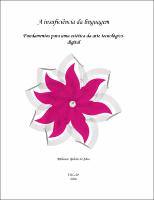Use este identificador para citar ou linkar para este item:
https://repositorio.pucsp.br/jspui/handle/handle/4802| Tipo: | Tese |
| Título: | A insuficiência da linguagem: fundamentos para uma estética da arte tecnológico-digital |
| Título(s) alternativo(s): | The insufficiency of language: fundaments for an aesthetics of the technological-digital art |
| Autor(es): | Silva, Edilamar Galvão da |
| Primeiro Orientador: | Bairon, Sérgio |
| Resumo: | Com o objetivo de descobrir o modo próprio como as recentes manifestações artísticas tecnológico-digitais enfrentam o problema da representação e da insuficiência da linguagem, esta tese investiga as relações entre mímesis, representação e arte como técnica, arte como invenção, arte e ciência, arte e linguagem e arte e indústria cultural. Neste trabalho, o reconhecimento da insuficiência da linguagem constitui um dos pilares de fundamentação de uma possível estética da arte tecnológico-digital. Este aspecto é abordado diacronicamente, desde Platão, com o conceito de mímesis, até a articulação lingüística dos textos místicos, aqui representados por Marguerite Porete e Pseudo Dionísio. O segundo pilar de fundamentação da estética tecnológico-digital é apresentado com base na crise da representação. Os modernos fizeram do reconhecimento da insuficiência da linguagem o motivo para a quebra do paradigma mimético da representação. Ortega y Gasset chamou de desumanização essa tendência a desviar do real como referente e chegou mesmo a prever, ainda que sem acreditar, numa arte completamente conceitual e abstrata, sem nenhum elemento humano . Essa desumanização criaria uma arte-artística , cujo prazer estético não estava mais fundado no reconhecimento entre obra de arte e vida, mas no prazer inteligente da compreensão. A recepção ativa , consistiria, então, nessa abertura da obra para a reflexão. Ao mesmo tempo, o desenvolvimento dos meios de comunicação de massa constituía um novo mercado para o que Theodor Adorno e Max Horkheimer chamaram de Indústria Cultural , utilizando uma linguagem de fácil reconhecimento entre a ficção e a percepção ideológica da realidade. Nesta perspectiva, as técnicas e tecnologias acabaram por merecer a culpa do empobrecimento do discurso o que é, no mínimo, uma compreensão muito parcial do pensamento de Adorno. Deste modo, esta tese estabelece as bases fundamentais para uma releitura da teoria crítica a partir da visão de uma nova estética ditada pelas novas tecnologias da comunicação. Os conceitos aqui apresentados são embasados nos estudos de estética subsumidos das obras de Immanuel Kant, Gilles Deleuze, Mário Costa e Lúcia Santaella |
| Abstract: | With the aim of discovering the proper way in which recent technological-digital artistic manifestations confront the problem of representation and the insufficiency of language, this thesis investigates the relationships between mimesis, representation and art as techniques, art as invention, art and science, art and language and art and cultural industry. In this work, the recognition of the insufficiency of the language constitutes one of the pillars upon which a possible aesthetics of technological-digital art is based. This aspect is approached diachronically, from Plato, with the concept of mimesis, to the linguistic articulation of the mystical texts, here represented by Marguerite Porete and Pseudo Dyonisius. The second pillar that fundaments the technological-digital aesthetics is presented based on the crisis of representation. Modern artists made from the recognition of the insufficiency of language the reason for breaking the mimetic paradigm of representation. Ortega y Gasset called de-humanization such tendency to divert from reality as reference, and anticipated, although not really believing in it, a completely conceptual and abstract art, with no human elements . Such de-humanization would create an artistic-art , whose aesthetic pleasure would no longer be based on the recognition between work of art and life, but on the intelligent pleasure of comprehension. Active reception would thus consist of this openness of the work to reflection. At the same time, the development of the mass media created a new market for what Theodor Adorno and Max Horkheimer called Cultural Industry , using an easily recognizable language between fiction and the ideological perception of reality. In this perspective, techniques and technologies ended up getting the blame for the impoverishment of the discourse which is a very partial comprehension of Adorno s thinking, to say the least. Thus this thesis establishes the fundamental bases for a new reading of critical theory from a vision of a new aesthetics determined by the new communications technologies. The concepts presented here are based on the studies of aesthetics conceived from the works of Immanuel Kant, Gilles Deleuze, Mário Costa and Lúcia Santaella |
| Palavras-chave: | Estética Arte tecnológico-digital Arte e indústria cultural, arte e linguagem, arte e ciência Insuficiência da linguagem Aesthetics Technological-digital art Art and cultural industry, art and language, art and science Insufficiency of language Arte digital Arte e tecnologia Mimesis na arte |
| CNPq: | CNPQ::CIENCIAS SOCIAIS APLICADAS::COMUNICACAO |
| Idioma: | por |
| País: | BR |
| Editor: | Pontifícia Universidade Católica de São Paulo |
| Sigla da Instituição: | PUC-SP |
| metadata.dc.publisher.department: | Comunicação |
| metadata.dc.publisher.program: | Programa de Estudos Pós-Graduados em Comunicação e Semiótica |
| Citação: | Silva, Edilamar Galvão da. A insuficiência da linguagem: fundamentos para uma estética da arte tecnológico-digital. 2006. 206 f. Tese (Doutorado em Comunicação) - Pontifícia Universidade Católica de São Paulo, São Paulo, 2006. |
| Tipo de Acesso: | Acesso Restrito |
| URI: | https://tede2.pucsp.br/handle/handle/4802 |
| Data do documento: | 14-Jun-2006 |
| Aparece nas coleções: | Programa de Pós-Graduação em Comunicação e Semiótica |
Arquivos associados a este item:
| Arquivo | Descrição | Tamanho | Formato | |
|---|---|---|---|---|
| Edilamar Galvao da Silva.pdf Restricted Access | 1,94 MB | Adobe PDF |  Visualizar/Abrir |
Os itens no repositório estão protegidos por copyright, com todos os direitos reservados, salvo quando é indicado o contrário.
